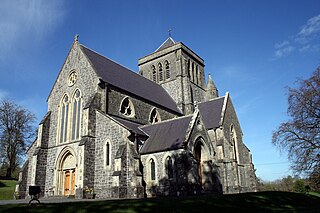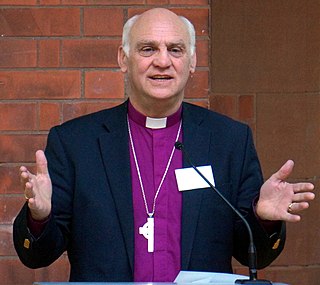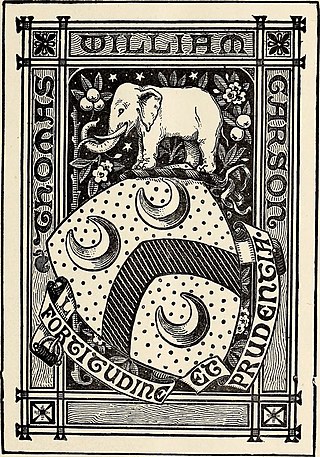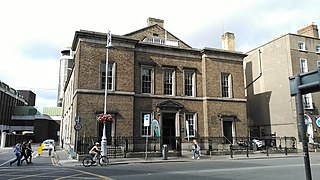
Magdalene asylums, also known as Magdalene laundries, were initially Protestant but later mostly Roman Catholic institutions that operated from the 18th to the late 20th centuries, ostensibly to house "fallen women". The term referred to female sexual promiscuity or sex workers, young women who became pregnant outside of marriage, or young girls and teenagers who did not have familial support. They were required to work without pay apart from meagre food provisions, while the institutions operated large commercial laundries, serving customers outside their bases.

The Bishop of Ardagh was a separate episcopal title which took its name after the village of Ardagh, County Longford in Ireland. It was used by the Roman Catholic Church until 1756, and intermittently by the Church of Ireland until 1839.

The Bishop of Kilmore is an episcopal title which takes its name after the parish of Kilmore, County Cavan in Ireland. In the Roman Catholic Church it remains a separate title, but in the Church of Ireland it has been united with other bishoprics.

The Bishop of Elphin is an episcopal title which takes its name after the village of Elphin, County Roscommon, Ireland. In the Roman Catholic Church it remains a separate title, but in the Church of Ireland it has been united with other bishoprics.
Albert Edward Hughes was Bishop of Kilmore, Elphin and Ardagh from 1939 to 1950.

Kenneth Herbert Clarke is the former Mission Director of SAMS UK & Ireland. He was Bishop of Kilmore, Elphin and Ardagh from 2001 until 2012.
Hamilton Verschoyle was a 19th-century Irish Anglican bishop who served as Bishop of Kilmore, Elphin and Ardagh from 1862 to his death.

The Rt Rev Thomas Carson, LLD was a 19th-century Irish Anglican Bishop.
Kilmore is a civil and ecclesiastical parish of County Cavan in Ireland. It is located about 3.5 miles (5.6 km) south-west of the county town of Cavan.
Lady Arabella Fitzmaurice Denny (1707–1792) was an Irish philanthropist, and founder of the Magdalen Asylum for Protestant Girls in Leeson Street, Dublin in 1765.
The Ulster Magdalene Asylum was founded in 1839 at Donegall Pass, Belfast, by the Church of Ireland. It cared for "fallen women" like other Magdalene asylums. It was founded as part of the St. Mary Magdalene Parish and was to provide an asylum for "penitent females" with a chapel attached and named the Ulster Magdalene Asylum and Episcopal Chapel. It was opened on 1 December 1839. While the laundry closed in 1916, the institution survived and the home operated until the 1960s. Set up to rehabilitate the women, generally, women who were pregnant out of wedlock, women involved in prostitution and others convicted of petty crimes. It was described, "For the reception of erring and repentant females". As the residents, in keeping with similar institutions, worked in a laundry, the Asylum was sometimes termed the "steam laundry".

The Molyneux Asylum for Blind Females was opened June 1, 1815 in Peter Street, Dublin, in what was formerly the residence of Thomas Molyneux (1641-1733), whose sister-in-law, Lucy Domville, had been blind. The building had been sold to Philip Astley, operating as Astley's Amphitheatre from 1789 to 1812, then the actor Henry Johnstone, intended to develop it as a theatre, however it reverted back to the Molyneux and was leased to a charity as an asylum for blind women. There was an Anglican church attached to the asylum. Music was an important part of the school and worship in the chapel. R.W. Beaty was an organist and music instructor from 1824. Henry Charles Shellard was organist and choirmaster from 1901 to 1955. The chapel was called the Albert Chapel, honoring the Queen's Husband.

The Bethesda Chapel, Dublin, was an Episcopal Church of Ireland, church on Granby Row and Dorset Street, Dublin.
William Henry Krause (1796–1852) was a Church of Ireland priest and noted preacher.

Trinity Church, Dublin, also called the Protestant Episcopal Church, was a Church of Ireland church on Gardiner Street in Dublin, Ireland, the building of which began in 1838. It closed around 1909 and was reopened in the 2000s by an independent Christian group.
Dublin Female Penitentiary was a reform institution for "fallen women" in Dublin, Ireland. It was established in 1810 and opened in 1813. It was run by the Church of Ireland and located between Berkeley Road, Eccles Street and North Circular Road. The institution could cater for over 40 inmates.
Ulster Female Penitentiary and Laundry or Edgar Home, was a Mother and Baby home in Brunswick Street, Belfast. It evolved out of an institution founded in 1816. It was initially non-denominational. It was greatly expanded and developed when it came under Presbyterian control and Rev. John Edgar and the new home was opened in November 1839. Other denominations had their similar institutions in Belfast, such as the Catholic Good Shepherd Home, Ballynafeigh, and the Anglican Ulster Magdalene Asylum, Donegall Pass, also established in 1839.
Dublin by Lamplight or the Lamplight Laundry, at 35 Ballsbridge Terrace, Ballsbridge, Dublin, was a Protestant-run Magdalene Laundry, founded in 1856, that like other such laundries housed so-called "fallen women". It was administered by a committee of Anglican women, a matron, and a chaplain who was a Church of Ireland priest. The motto of the asylum was "That they may recover themselves out of the snares of the devil".









